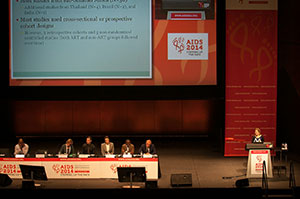Stepping Up the Pace in America’s Response to AIDS
Topics

Given the global reach of the AIDS epidemic and the diversity of delegates who attended the 20th International AIDS ConferenceExit Disclaimer (AIDS 2014) in Melbourne, Australia (July 20-25), it’s not surprising that hundreds of topics were presented. Plenary sessions, symposia, and posters covered subjects ranging from novel ways to reach high-risk populations, harm reduction strategies for persons who use drugs, efforts to combat HIV criminalization, strategies to modify health systems so as to improve HIV care outcomes, and the future of a cure for HIV. And many of us were heartened to see that the conference organizers had included several sessions on the global impact of hepatitis B and hepatitis C.
There is no way that a single blog can do justice to the breadth and depth of material presented in Melbourne and I encourage readers to visit the conference programExit Disclaimer to review individual conference abstracts. But as someone who has been privileged to attend all but the very first International AIDS Meeting (held in Atlanta, Georgia in 1985), I’d like to reflect on several high-level themes that emerged from this year’s conference, and consider what they mean in the context of our own nation’s efforts to achieve the goals of the U.S. National HIV/AIDS Strategy.
Step up the Pace
“Stepping up the Pace” was the theme of the meeting and several presenters made reference to a “tipping point,” that is, those situations where HIV progress could just as easily go backwards as forwards. True, there are fantastic examples from around the globe of tremendous progress against HIV/AIDS, like global treatment scale-up, facilitated by investments in PEPFAR. But there are also instances where we have lost ground. In our own nation, and in many other parts of the world, rising HIV incidence among gay and other men who have sex with men (MSM), must be seen as a warning to step-up investment in evidence-based HIV prevention and care programs for these populations and to actively confront the stigma and homophobia which aids and abets HIV’s spread.
Implement the Science

We wouldn’t be able to talk about an AIDS-free generation without the substantial advances in basic, clinical, and prevention science that have accrued over the past three decades. But it is increasingly clear that scientific breakthroughs, in many ways, represent the beginning, rather than the end, of our response to the HIV/AIDS epidemic. Whether we consider the policy implications of HIV treatment as prevention (TasP) or explore the operational issues inherent in implementing HIV pre-exposure prophylaxis (PrEP), it is crucial that we actively engage communities and other stakeholders in an ongoing dialogue about what these scientific advances mean to end users and affected communities. Further, disseminating scientific breakthroughs often requires that we educate policy makers as well as undertake changes to existing systems of care; these steps are necessary if we want to promote the uptake of new technologies and practices. Finally, understanding and addressing the social and environmental circumstances that can block the uptake of advances in HIV science is paramount. Intervening to modify these structural impediments is how we will eventually reduce the persistent racial/ethnic disparities that characterize the U.S. HIV/AIDS epidemic.
Stay in it for the Long Haul
Ongoing vaccine research and the expanding discourse on a cure for HIV speak to our need for new and better science in order to conquer this virus. But if we are to achieve the goals of America’s National HIV/AIDS Strategy and become a nation where new HIV infections are rare and HIV health disparities and inequities have vanished, we must replenish other resources—in addition to science. We need new and better data to plot our course, new ways to confront the barriers that interfere with optimal HIV prevention and care and, perhaps most important of all, new leaders to bring to this fight. The battle against this virus has already spanned generations and will likely continue to do so. Events like the International AIDS Conference, the U.S. Conference on AIDS, and the National HIV Prevention Meeting, among others, provide critical opportunities to mentor a new generation of AIDS leadership. And so to our next generation of scientists, advocates, providers, public health workers, and policy makers I say please join the fight so we can step up the pace.